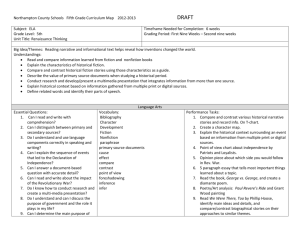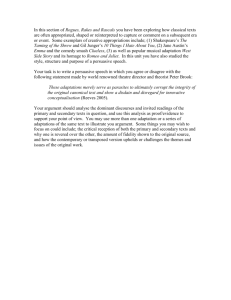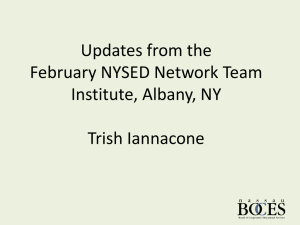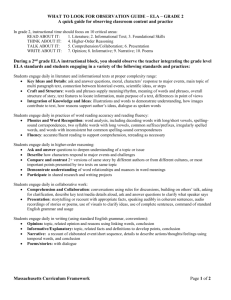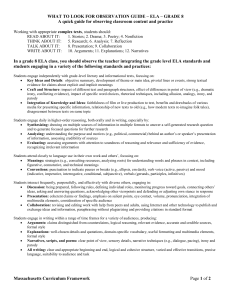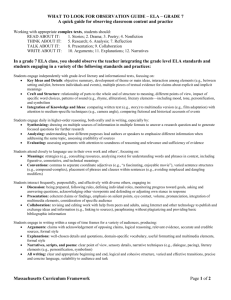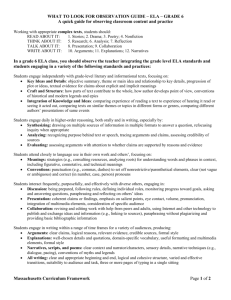Sample Interdisciplinary Performance Tasks
advertisement
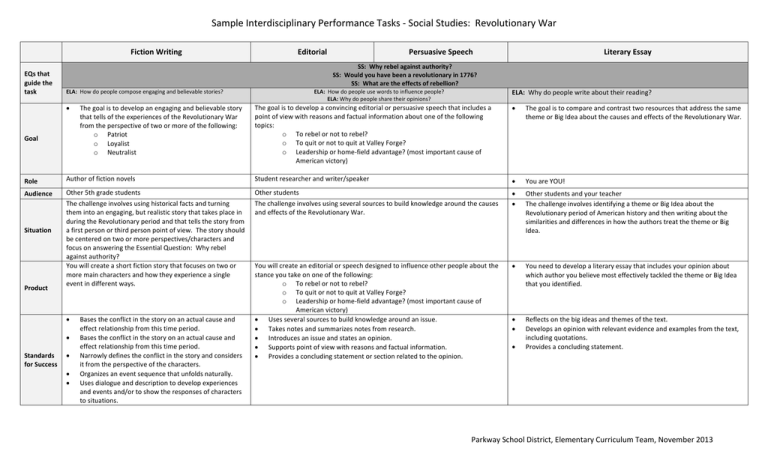
Sample Interdisciplinary Performance Tasks - Social Studies: Revolutionary War Fiction Writing EQs that guide the task Editorial Persuasive Speech Literary Essay SS: Why rebel against authority? SS: Would you have been a revolutionary in 1776? SS: What are the effects of rebellion? ELA: How do people compose engaging and believable stories? Goal The goal is to develop an engaging and believable story that tells of the experiences of the Revolutionary War from the perspective of two or more of the following: o Patriot o Loyalist o Neutralist ELA: How do people use words to influence people? ELA: Why do people share their opinions? ELA: Why do people write about their reading? The goal is to develop a convincing editorial or persuasive speech that includes a point of view with reasons and factual information about one of the following topics: o To rebel or not to rebel? o To quit or not to quit at Valley Forge? o Leadership or home-field advantage? (most important cause of American victory) The goal is to compare and contrast two resources that address the same theme or Big Idea about the causes and effects of the Revolutionary War. Role Author of fiction novels Student researcher and writer/speaker You are YOU! Audience Other 5th grade students Other students The challenge involves using historical facts and turning them into an engaging, but realistic story that takes place in during the Revolutionary period and that tells the story from a first person or third person point of view. The story should be centered on two or more perspectives/characters and focus on answering the Essential Question: Why rebel against authority? You will create a short fiction story that focuses on two or more main characters and how they experience a single event in different ways. The challenge involves using several sources to build knowledge around the causes and effects of the Revolutionary War. Other students and your teacher The challenge involves identifying a theme or Big Idea about the Revolutionary period of American history and then writing about the similarities and differences in how the authors treat the theme or Big Idea. You need to develop a literary essay that includes your opinion about which author you believe most effectively tackled the theme or Big Idea that you identified. Reflects on the big ideas and themes of the text. Develops an opinion with relevant evidence and examples from the text, including quotations. Provides a concluding statement. Situation Product Standards for Success Bases the conflict in the story on an actual cause and effect relationship from this time period. Bases the conflict in the story on an actual cause and effect relationship from this time period. Narrowly defines the conflict in the story and considers it from the perspective of the characters. Organizes an event sequence that unfolds naturally. Uses dialogue and description to develop experiences and events and/or to show the responses of characters to situations. You will create an editorial or speech designed to influence other people about the stance you take on one of the following: o To rebel or not to rebel? o To quit or not to quit at Valley Forge? o Leadership or home-field advantage? (most important cause of American victory) Uses several sources to build knowledge around an issue. Takes notes and summarizes notes from research. Introduces an issue and states an opinion. Supports point of view with reasons and factual information. Provides a concluding statement or section related to the opinion. Parkway School District, Elementary Curriculum Team, November 2013 Sample Interdisciplinary Performance Tasks - Social Studies: Revolutionary War Key Considerations: 1. Like other informational texts, Social Studies-related texts are usually organized using problem-solution, cause-effect, and compare-contrast structures. Alerting students to these structures not only helps them navigate the texts in a more efficient and effective way, it also helps them begin to think about patterning their own writing in the content area after these structures. 2. The ability to engage in the close reading of Social Studies-related texts is a critical factor in determining the quality of the product that students create to represent their understanding of the topic. Mary Ehrenworth, deputy director of the Teachers College Reading and Writing Project at Columbia University, has suggested that it is important to teach students that there are “predictable questions readers can ask as they read to get more out of their reading.” Some questions that readers might pose are: What does this text want me to know? What information does this text teach? What does this text want me to understand? What new ideas and concepts does it suggest? What does this text want me to feel? What emotions does it stir up? How does it accomplish these tasks? Who perspective is represented in this text? Who point of view is most fully explored? Who is honored or privileged in the text and how? Who is marginalized? How does the perspective in this text compare with others on this issue? How does the author use persuasive techniques, literary devices, or writerly craft to convey meaning? 3. The ELA-Reading units teach students the skills of navigating non-fiction texts. It is critical to make intentional connections to these skills when students are engaged with Social Studies-related texts. If a performance task by a student lacks quality, relevant details and “misses the point”, consider teaching directly into these ELA skills during Social Studies. Parkway School District, Elementary Curriculum Team, November 2013


